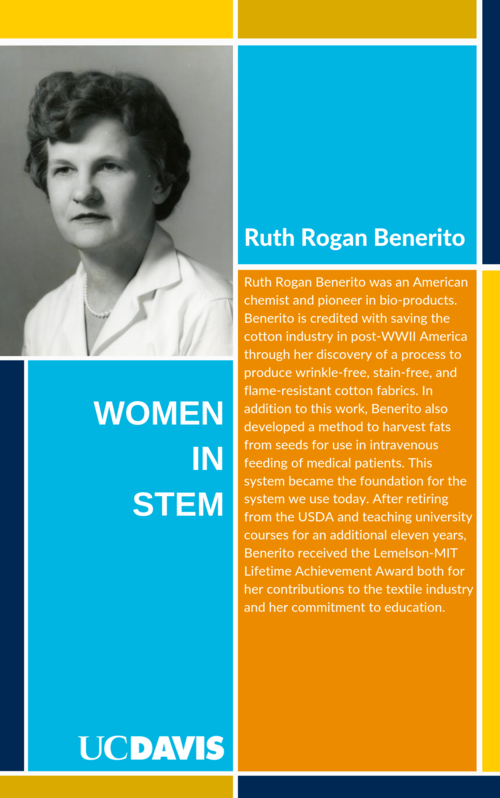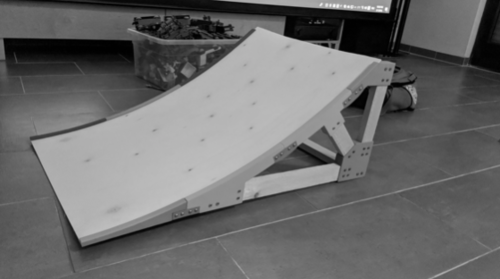Chain Reaction Challenge Part 1
Invent a wacky multi-step machine to complete a simple task
SESSION ROLES:
🐙 = Site Coordinator
🦉= Mentor
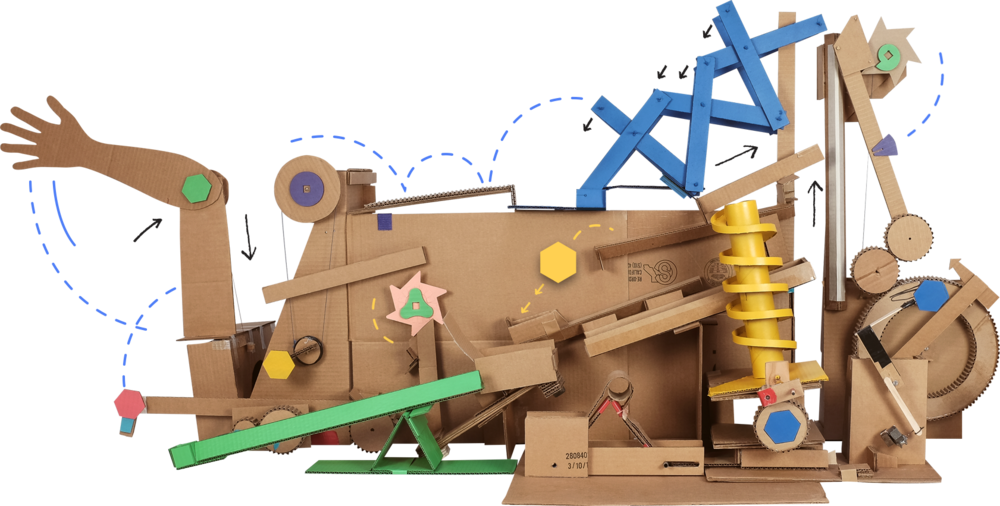
Notes for Site Coordinators and Mentors:
-
This challenge is structured as two individual 2hr sessions. This session is Part 1 of the Chain Reaction Challenge.
-
This session guide provides a detailed outline for part 1 of the Chain Reaction Challenge, but feel free to improvise or put your own spin to things. If you do change things up, we would love to hear what has been successful for you!
Session Overview
The Chain Reaction Challenge is structured as two individual 2hr sessions. This session is Part 1 of the Chain Reaction Challenge.
Inspired by Rube Goldberg, this session challenges students to explore a variety of mechanical interactions and solve a very simple problem in a wacky and complex way.
Students will brainstorm ideas and then use the littleBits Invention Cycle to perform a simple task with a chain reaction contraption. Then they will build and test multiple prototypes of their favorite idea. At the close of the session, students will create videos or cartoons of their chain reaction contraption in action.
As an added challenge, combine multiple group’s contraptions together for a mega reaction!
Session Details
Difficulty:
Intermediate
Duration:
2 hours
Subjects:
Engineering
Art/Design
Science
Prerequisite Knowledge:
Supplies
Bits + Accessories:
STEM Inventor Kit
Device:
Mentors will need to bring a connected device (phone, tablet, or computer) to access instructional videos
Recycled Materials:
Ex: cardboard, cereal boxes, plastic bottles, etc. You can work with students and mentors to collectively bring these supplies in as needed.
Tools:
Scissors
Other Materials:
Extra 9V batteries
Tape
Small balls (like marbles, bouncy balls, round beads)
Pen/Pencil & Paper
Books
Description
Theme: Simple Machines
Objectives: By the end of the Chain Reaction Challenge, students will be able to:
-
Brainstorm ideas for meeting the designated challenge
-
Create and test a circuit containing a power source, inputs, outputs, and wires
-
Construct a prototype of an invention using Bits and other materials
-
Test their prototypes and make improvements
-
Demonstrate their ability to Create, Play, Remix and Share an invention through the littleBits Invention Cycle
-
Summarize their process and demonstrate how their chain reaction contraption completes a simple task in a complex way.
Resources
Inspirational Links:
littleBits Rube Goldberg Machines
Helpful Links:
Set Up
🐙SITE COORDINATORS:
-
Make sure all the supplies for this session are prepped and ready to go. Discuss with mentors if you need help gathering recycled materials.
-
Place a variety of construction materials and tools in a central location in the room.
-
-
The Chain Reaction Challenge is made up of two ~2hr sessions. Note that students will need to be able to store their in-progress inventions in between sessions 1 & 2.
-
This challenge can be done individually or in small groups (2–3 students). Decide beforehand what makes the most sense for your site.
-
For an advanced challenge, have the whole group collaborate to invent a massive contraption!
-
-
For this challenge, we suggest handing out the kits during the CREATE phase (after the ideation activities) to keep focused on initial instructions.
🦉MENTORS:
-
Make sure to bring a charged connected device (phone, iPad, or computer) to access instructional videos during the session.
Meet Up
5 MIN
🐙SITE COORDINATORS:
Take attendance and make sure mentors are paired off.
🦉MENTORS:
Take turns asking each other questions. Example prompts:
-
What's one thing you created or invented this week?
Introduce
10 MIN
🐙SITE COORDINATORS INTRODUCE THE SESSION
Introduce the session objectives and the concept behind the session:
“Rube Goldberg was a cartoonist who liked to draw really complicated solutions to very simple problems. For example, to turn the page of a book, you might roll a ball down a ramp that hits a box. Then the box falls over and scares a hamster that starts running on its wheel, that winds up a string that turns the page. In this challenge, you’re going to design your own multi-step machines. Before you start inventing, there are two important rules: 1) Once you start your machine, it needs to be able to run without any help from you. Each step must be triggered automatically by the step before it, and 2) Your machine should have at least two steps (bonus points if you can create more!)”
Share videos and/or cartoons of Rube Goldberg machines to provide context and inspiration.
Most design challenges focus on how life can be made easier by an invention. This challenge is a fun exploration in the opposite direction. How complicated can we make a very simple task? To this end, you may work in a little absurdity and whimsy.
Before jumping into the challenge, provide a quick review of the Invention Cycle framework. Ask students to share lessons learned about Bits, the invention process and things they enjoyed or struggled with from previous challenges.
Goals for Chain Reaction Challenge PART 1
-
Brainstorm ideas for a multi-step machine that completes a task
-
Experiment with simple machines
-
Explore interactions with different Bits and materials
-
Choose a direction to work towards
-
Create a sketch of the invention idea
-
Start creating a prototype
Inspire
10 MIN
🦉MENTORS REVIEW SESSION INSPIRATION VIDEOS AND PROMPTS
Career Exploration
As a warm up activity, mentors will explore two women in STEM who have made significant contributions to their field. Please take a few minutes to review the bios provided in the postcards below and brainstorm with your mentee what contributions she would make as a leader in this field fifteen years from now. Ask your mentee(s) the following:
- Can you see yourself in her job?
- Are you interested to learn more about her job?
- What inspires you about this role model?
(Expand on some phrases or words that may be difficult to understand.)
*The purpose of the postcards are meant to provide girls with the career endeavors and examples of STEM positions of successful women in STEM to inspire them and explore different types of careers in STEM.*
Download Women in STEM postcards here:
RUTH ROGAN BENERITO EVA RAMON GALLEGOS
INSPIRATIONAL INVENTION VIDEOS OF THE DAY
Rube Goldberg was a cartoonist, engineer, and inventor who created chain reaction contraptions to perform simple tasks. He inspired many inventor’s to make their own Rube Goldberg machines. Here are some examples:
Joseph Hersher: An easy way to be more productive at lunch time
OK Go - Giant Rube Goldberg
Rube Goldberg Machines made with littleBits
Six Rube Goldberg Machines
Create
80 MIN
🦉MENTORS:
Facilitate the CREATE activities with mentees.
🐙SITE COORDINATORS:
During the CREATE activities, float around the room and observe/help out where needed. You will also monitor the time and announce when the group should come together to share.
Change Reaction Challenge
Invent a wacky multi-step machine to complete a simple task.
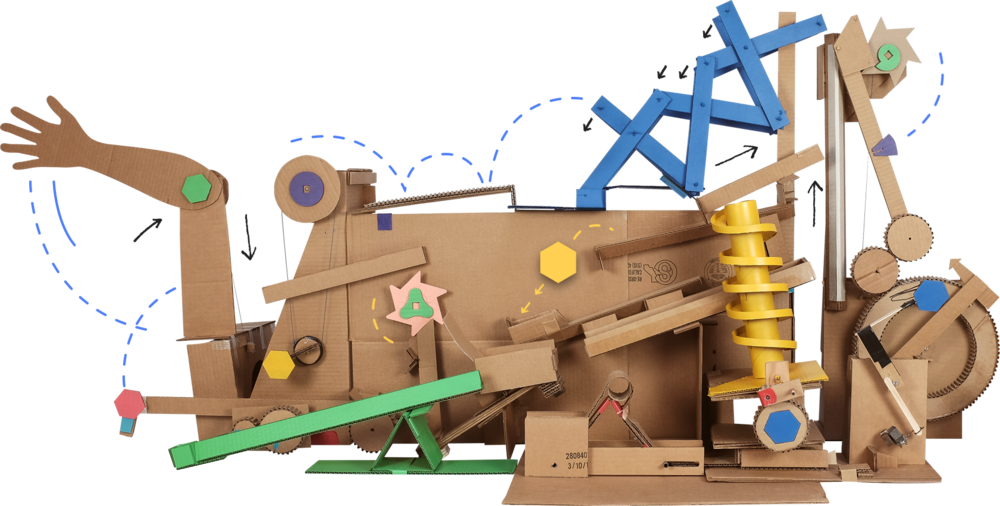
Brainstorm
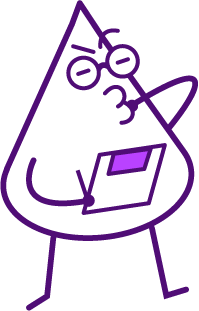
-
Prompt students to create a list of everyday activities that only take one step. For example, dropping a can in the recycling bin, flipping on a light switch or opening a book. Record these ideas on a piece of paper to refer to as you build.
-
Come up with 5-10 ideas and write them down. No idea is a bad idea!
Choose an Idea
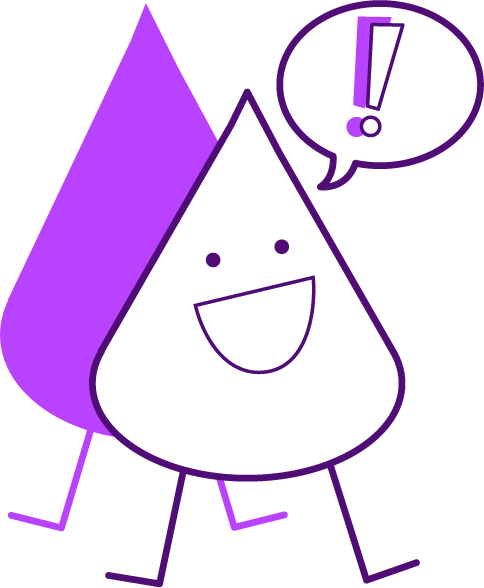
-
After making a list of 5–10 ideas, students should choose the everyday activity that they want to accomplish. It could be the idea that sounds the most fun to solve or is the most accessible at your location.
-
You can always come back to the other ideas later.
Explore your Bits and Accessories
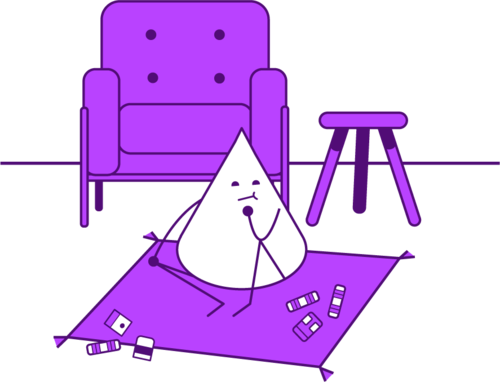
-
Instruct students to look through their available Bits and accessories to see how they could (or couldn’t) be combined to help solve your problem. For example, how could a servo trigger a slide dimmer? How could a buzzer trigger a sound sensor? Could the latch play a role?
-
Test out different Bit combinations to see you can achieve the interactions you want.
-
Use the DCI STEM STEM Kit Bit Index for more info about each Bit.
Experiment with Materials to Create Simple Machines
How could other materials (e.g. books, cardboard, cups) serve as triggers? Here is some inspiration. Get started by watching these intro videos:
MACHINE BASICS
INCLINED PLANES / RAMPS
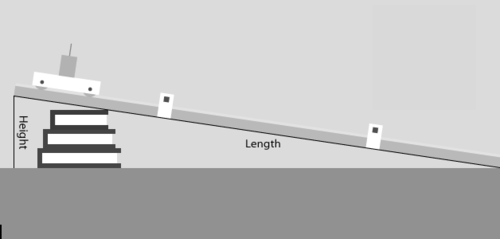
MINI CHALLENGE #1
Build two simple inclined planes. You can use cardboard or found objects. Test rolling a small ball down the ramps. Which ramp is faster?
MINI CHALLENGE #2
Create a marble run by building a series of book ramps. See how many levels you can create.
LEVERS
MINI CHALLENGE #3
Build a lever out of cardboard or found materials. Place an object on one end of the lever and experiment with what weight you need to cause it to tip.
MINI CHALLENGE #4
Create a marble run that uses both inclined planes AND levers. Try to come up with as many actions as possible for your ball to move through.
*YOU CAN SAVE PARTS AND PIECES FROM YOUR EXPERIMENTS TO USE IN THE NEXT SESSION WHEN YOU BUILD A PROTOTYPE FOR YOUR CHAIN REACTION CONTRAPTION
Sketch Out Your Chain Reaction Contraption
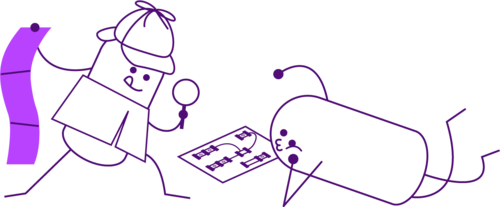
-
What task are you trying to complete?
-
Label what Bits and materials do you plan to use (*Note: your machine must use littleBits)
-
How do you plan to combine different elements?
-
How does it work?
-
What do you want your invention to look like?
*SAVE THIS SKETCH FOR REFERENCE IN THE NEXT SESSION
Make a plan for next session
-
In the next session, students will test, improve, and then demonstrate their chain reaction contractions for the group (or as one giant machine).
-
Discuss with your mentee if there are any special materials they want to use for their invention.
-
Make a plan to bring these materials for next session if you don’t have them in this session. Perhaps you can divide and conquer - you can bring a few things and so can your mentee.
Reflect
5 MIN
🦉MENTORS:
Reflect with your mentee: “What is one new thing that you learned during this challenge?”
Close
10 MIN
Wrap Up
🦉MENTORS:
-
Discuss with your mentee if there are any special materials they want to use for their final invention. Make a plan to bring these materials for next session. Perhaps you can divide and conquer - you can bring a few things and so can your mentee.
-
Make sure to power off the Power Bit and disconnect the battery.
-
Place all Bits & Accessories that you are not using back in the box.
-
Store the sketch in the kit box as well so you can reference it next time.
🐙SITE COORDINATORS:
-
Find a safe place to store prototypes until the next session.
-
Store kits away for next time.
-
Announce plan for next session:
-
Create a prototype of a machine that combines littleBits and other materials to complete a task
-
Test your prototype
-
Iterate and make updates to the invention
-
Share with the group how your machine completes a task
-

